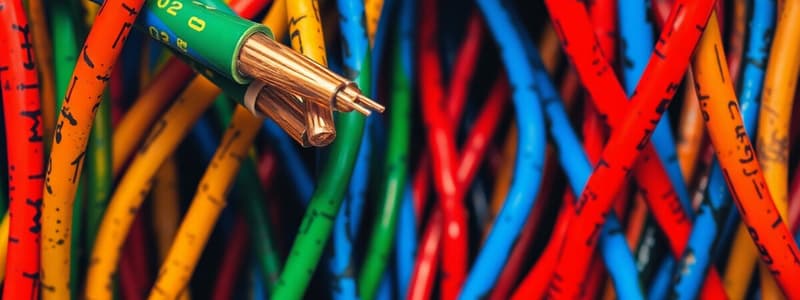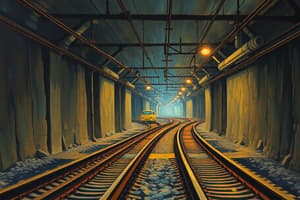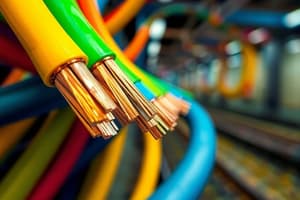Podcast
Questions and Answers
Railway departmental telecommunication lines are usually laid underground between railway offices in railway colonies, large workshops, station yards and in the block sections alongside the ______.
Railway departmental telecommunication lines are usually laid underground between railway offices in railway colonies, large workshops, station yards and in the block sections alongside the ______.
track
All telecom lines shall, as far as possible, be laid in a manner that due provisions are kept for any future ______ or extra connection.
All telecom lines shall, as far as possible, be laid in a manner that due provisions are kept for any future ______ or extra connection.
extensions
The following types of underground cables are generally used for various telecommunication circuits including Quad Cable and ______ Cable.
The following types of underground cables are generally used for various telecommunication circuits including Quad Cable and ______ Cable.
Multi pair
Quad Cable has a conductor diameter of either 0.9 mm or ______ mm as per IRS specification No.IRS:TC 30/05.
Quad Cable has a conductor diameter of either 0.9 mm or ______ mm as per IRS specification No.IRS:TC 30/05.
1.4 mm Quad cable is desirable in block sections longer than ______ kms.
1.4 mm Quad cable is desirable in block sections longer than ______ kms.
Twisted Pair Switch Board Cable is generally used for indoor applications such as distribution to various telephone ______ in a building.
Twisted Pair Switch Board Cable is generally used for indoor applications such as distribution to various telephone ______ in a building.
Multi pair Cable can have between 10 pairs to ______ pairs.
Multi pair Cable can have between 10 pairs to ______ pairs.
If RE cable containing paper as well as polythene insulated copper quads is still available, it should be planned to replace the same at the ______.
If RE cable containing paper as well as polythene insulated copper quads is still available, it should be planned to replace the same at the ______.
Thermo shrinkable jointing material shall be used for jointing armoured PIJF cable with thermo shrinkable jointing technique using RDSO's code of ______.
Thermo shrinkable jointing material shall be used for jointing armoured PIJF cable with thermo shrinkable jointing technique using RDSO's code of ______.
For quad cable, only Reinforced Thermo Shrink Jelly Filled kit (RTSF) type jointing kit to be used as per latest RDSO ______.
For quad cable, only Reinforced Thermo Shrink Jelly Filled kit (RTSF) type jointing kit to be used as per latest RDSO ______.
Quad cable joint may normally be kept underground or it may be housed inside a ______ box of proper size avoiding sharp bends.
Quad cable joint may normally be kept underground or it may be housed inside a ______ box of proper size avoiding sharp bends.
The screen and armour of copper cables to be jointed shall be made through with suitable ______.
The screen and armour of copper cables to be jointed shall be made through with suitable ______.
The copper cable screen and armour shall be earthed with a low value ______.
The copper cable screen and armour shall be earthed with a low value ______.
The size of the telephone exchange cables shall be specified indicating the number of ______, dia. of conductor, and type of insulation.
The size of the telephone exchange cables shall be specified indicating the number of ______, dia. of conductor, and type of insulation.
For outdoor under ground cables, the conductor size of 0.5 mm is used for subscriber's connection up to ______ kms.
For outdoor under ground cables, the conductor size of 0.5 mm is used for subscriber's connection up to ______ kms.
Continuity of ______ and screen of the cable need to be checked before laying.
Continuity of ______ and screen of the cable need to be checked before laying.
Bedding and ______ of the cable shall also be inspected to see that there has been no damage during transit or in storage.
Bedding and ______ of the cable shall also be inspected to see that there has been no damage during transit or in storage.
The cable drums shall be mounted on ______ for laying out cables.
The cable drums shall be mounted on ______ for laying out cables.
In underground laying, only ______ filled armoured cables are to be used.
In underground laying, only ______ filled armoured cables are to be used.
A party of labours shall follow the drum and guide the cable from the road into the trench so that the cable is not ______ or bent unduly.
A party of labours shall follow the drum and guide the cable from the road into the trench so that the cable is not ______ or bent unduly.
The size of conductor for a trunk connection is typically ______ mm ATC.
The size of conductor for a trunk connection is typically ______ mm ATC.
In case where the wheels are not available, the drum shall be mounted on an axle at one end of the trench and ______ laid out and carried by labourers.
In case where the wheels are not available, the drum shall be mounted on an axle at one end of the trench and ______ laid out and carried by labourers.
In no case, shall the drum be rolled off on to the road for laying the cable and the cable dragged on the ______ for laying purposes.
In no case, shall the drum be rolled off on to the road for laying the cable and the cable dragged on the ______ for laying purposes.
While excavating earth for trenches or making other pits necessary for installation of cable junction boxes, the ______ Way Inspector or his representative shall be present.
While excavating earth for trenches or making other pits necessary for installation of cable junction boxes, the ______ Way Inspector or his representative shall be present.
In telephone cables, electro-static and electro-magnetic induction between different pairs of conductors shall be minimized by a lead or ______ sheath.
In telephone cables, electro-static and electro-magnetic induction between different pairs of conductors shall be minimized by a lead or ______ sheath.
Whenever a road-crossing or rail-crossing is encountered in busy areas, ______ method should be used to lay all types of cables.
Whenever a road-crossing or rail-crossing is encountered in busy areas, ______ method should be used to lay all types of cables.
Where concrete large size duct is provided in the station section for laying signalling cables, the same may be utilized for telecom cables also following due ______.
Where concrete large size duct is provided in the station section for laying signalling cables, the same may be utilized for telecom cables also following due ______.
Cables can be terminated in any of the following methods: DP Box of approved ______ or Direct termination.
Cables can be terminated in any of the following methods: DP Box of approved ______ or Direct termination.
Jointing should be done by a skilled and experienced person using the correct RDSO specified ______ kit to ensure quality.
Jointing should be done by a skilled and experienced person using the correct RDSO specified ______ kit to ensure quality.
Flashcards are hidden until you start studying
Study Notes
Railway Telecom Line Plant Systems - Underground Copper Cable
-
Railway telecommunications lines are typically laid underground between railway offices, workstations, and track sections.
-
Spare Capacity: All telecom lines should be installed with future expansion in mind, allowing for new connections without major alterations to existing circuits.
Underground Copper Cable Types and Performance Parameters
-
Cable Types:
- Quad Cable: 0.9mm or 1.4mm conductor diameter, used for control circuits and block interfaces. 1.4mm cable is preferred for block sections longer than 12km.
- Multi-Pair Cable: (10 to 200 pairs) with various conductor diameters (0.5mm/0.63mm/0.9mm), used for subscriber lines or branch cables.
- Twisted Pair Switch Board Cable: 0.5mm/0.6mm copper conductor diameter, used for indoor applications like building distribution and MDF to exchange wiring.
- RE Cable: Older paper and polythene insulated quads should be replaced as soon as possible.
-
Cable Sizes for Outdoor and Indoor Applications:
- Outdoor:
- 0.5mm conductor diameter (1.83 kg/km) for subscriber connections up to 5km.
- 0.63mm conductor diameter (2.81 kg/km) for subscriber connections up to 10km.
- Indoor:
- 0.5mm Annealed Tinned Copper (ATC) Switchboard cable (1.76 kg/km) for local subscriber connections and exchange to MDF wiring.
- 0.6mm ATC Switchboard cable (2.52 kg/km) for trunk connections.
- Outdoor:
-
Exchange Cable Specification:
- Specify the number of pairs, conductor diameter, insulation/sheath type, jelly filled, armoured, or unarmoured.
- For underground installations, only jelly filled armoured cables should be used.
Cable Testing and Laying
-
Pre-Laying Testing:
- Conduct insulation and continuity tests on cable cores before laying.
- Inspect cable bedding and armouring for damage before laying.
-
Laying Procedure:
- Use cable wheels to move cable drums along the trench.
- Guide the cable into the trench carefully, avoiding damage or bending.
- If wheels are unavailable, mount the drum on an axle and transport the cable manually.
- Do not drag the cable across the ground.
General Considerations
-
Excavation and Permanent Way:
- The Permanent Way Inspector or representative should be present during excavation and construction of junction boxes near the track.
- Quad cable circuits use diagonally opposite conductors.
-
Electromagnetic Induction Reduction:
- Lead or aluminum sheaths and twisted pairs minimize electromagnetic induction between cable pairs.
-
Road and Rail Crossings:
- Use Horizontal Directional Drilling (HDD) to lay cables in DWC pipes or other approved protective arrangements in busy areas.
-
Station Sectional Duct:
- Telecom cables can be laid in large concrete ducts designated for signaling cables, with appropriate safety measures.
Termination and Jointing
-
Cable Termination Methods:
- Approved DP Box.
- Direct termination.
-
PIJF Cable Termination:
- Use approved DP Box.
-
PIJF Cable Jointing:
- Only skilled and experienced personnel should use the correct RDSO-specified jointing kit.
- Ensure close supervision of telecom staff during laying and jointing.
- Video recording can be used to document the quality of laying and jointing.
- Use thermo-shrinkable jointing material for armored PIJF cables with thermo-shrinkable jointing techniques.
- Use the correct jointing kit (TSF-1, TSF-2, etc.) for the cable size.
- Use a Reinforced Thermo Shrink Jelly Filled (RTSF) kit for quad cables.
- Place quad cable joints underground or in a location box with proper size and EC Socket.
- Paint the location box with black and yellow stripes.
- Joint the screen and armour with suitable wires for the specified screening factor and earthing.
- Ensure the screen and armour are earthed with a low value earth to avoid electric shock.
Studying That Suits You
Use AI to generate personalized quizzes and flashcards to suit your learning preferences.




